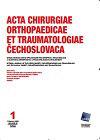[Thoracolumbar Compression Fractures in Children].
IF 0.4
4区 医学
Q4 ORTHOPEDICS
Acta chirurgiae orthopaedicae et traumatologiae Cechoslovaca
Pub Date : 2023-06-22
DOI:10.55095/achot2023/020
引用次数: 0
Abstract
PURPOSE OF THE STUDY The study aimed to draw up a diagnosis and treatment guidelines for the management of the most common compression fractures of the thoracolumbar spine in children. MATERIAL AND METHODS Between 2015 and 2017, pediatric patients with a thoracolumbar injury aged 0-12 years were followed up in the University Hospital in Motol and the Thomayer University Hospital. The age and gender of the patient, injury etiology, fracture morphology, number of injured vertebrae, functional outcome (VAS and ODI modified for children), and complications were assessed. An X-ray was performed in all patients, in indicated cases also an MRI scan was done, and in more severe cases a CT scan was obtained as well. RESULTS The average vertebral body kyphosis in patients with one injured vertebra was 7.3° (range 1.1°-12.5°). The average vertebral body kyphosis in patients with two injured vertebrae was 5.5° (range 2.1°-12.2°). The average vertebral body kyphosis in patients with more than two injured vertebrae was 3.8° (range 0.2°-11.5°). All patients were treated conservatively in line with the proposed protocol. No complications were observed, no deterioration of the kyphotic shape of the vertebral body was reported, no instability occurred, and no surgical intervention had to be considered. DISCUSSION Pediatric spine injuries are in most cases treated conservatively. Surgical treatment is opted for in 7.5-18% of cases, in dependence on the evaluated group of patients, age of the patients and philosophy of the department concerned. In our group, all patients were treated conservatively. CONCLUSIONS 1. To diagnose F0 fractures, two unenhanced orthogonal view X-rays are indicated, whereas MRI examination is not routinely performed. In F1 fractures, an X-ray is indicated, and an MRI scan is considered based on the age and extent of injury. In F2 and F3 fractures, an X-ray is indicated and subsequently the diagnosis is confirmed by MRI, in F3 fractures also a CT scan is performed. 2. In young children (under 6 years of age), in whom an MRI procedure would require general anaesthesia, MRI is not routinely performed. 3. In F0 fractures, crutches or a brace are not indicated. In F1 fractures, verticalization using crutches or a brace is considered in dependence on the patient's age and extent of injury. In F2 fractures, verticalization using crutches or a brace is indicated. 4. In F3 fractures, surgical treatment is considered, followed by verticalization using crutches or a brace. In case of conservative treatment, the same procedures as in F2 fractures are applied. 5. Long-term bed rest is contraindicated. 6. Duration of spinal load reduction (restriction of sports activities, or verticalization using crutches or a brace) in F1 injuries is 3-6 weeks based on the age of the patient, it increases with the age, with the minimum being 3 weeks. 7. Duration of spinal load reduction (verticalization using crutches or a brace) in F2 and F3 injuries is 6-12 weeks based on the age of the patient, it increases with the age, with the minimum being 6 weeks. Key words: pediatric spine injury, thoracolumbar compression fractures, children trauma treatment.[儿童胸腰椎压缩性骨折]。
本研究旨在制定一份诊断和治疗指南,以治疗儿童胸腰椎最常见的压缩性骨折。材料和方法2015年至2017年间,在莫托尔大学医院和托马耶大学医院对0-12岁的胸腰段损伤儿童患者进行了随访。评估患者的年龄和性别、损伤病因、骨折形态、损伤椎骨数量、功能结果(儿童改良VAS和ODI)和并发症。所有患者都进行了X光检查,在指示的病例中还进行了MRI扫描,在更严重的病例中也进行了CT扫描。结果一节椎骨损伤患者的平均椎体后凸为7.3°(范围1.1°-12.5°),两节椎骨损伤的患者的平均脊柱后凸为5.5°(范围2.1°-12.2°),超过两节椎骨的患者的椎体后凸平均为3.8°(范围0.2°-11.5°)拟议的协议。没有观察到并发症,没有报告椎体后凸形状恶化,没有发生不稳定,也没有考虑手术干预。讨论儿童脊柱损伤在大多数情况下是保守治疗的。根据评估的患者群体、患者年龄和相关科室的理念,7.5-18%的病例选择了手术治疗。本组所有患者均接受保守治疗。结论1。为了诊断F0骨折,需要两个未增强的正交视图X光片,而MRI检查不是常规检查。在F1骨折中,需要进行X光检查,并根据损伤的年龄和程度考虑进行MRI扫描。在F2和F3骨折中,指示X射线,随后通过MRI确认诊断,在F3骨折中还进行CT扫描。2.对于需要全身麻醉才能进行MRI检查的幼儿(6岁以下),MRI检查不是常规检查。3.F0骨折不需要使用拐杖或支架。在F1骨折中,使用拐杖或支架进行垂直化视患者的年龄和损伤程度而定。在F2骨折中,需要使用拐杖或支架进行垂直化。4.F3骨折考虑手术治疗,然后使用拐杖或支架进行垂直治疗。在保守治疗的情况下,采用与F2骨折相同的程序。5.禁止长期卧床休息。6.F1损伤的脊柱负荷减少(限制运动活动,或使用拐杖或支架垂直化)的持续时间为3-6周,根据患者的年龄而定,随着年龄的增长而增加,最短为3周。7.根据患者的年龄,F2和F3损伤的脊柱负荷减轻(使用拐杖或支架垂直化)的持续时间为6-12周,随着年龄的增长而增加,最短为6周。关键词:小儿脊柱损伤,胸腰椎压缩性骨折,儿童创伤治疗。
本文章由计算机程序翻译,如有差异,请以英文原文为准。
求助全文
约1分钟内获得全文
求助全文
来源期刊
CiteScore
0.70
自引率
25.00%
发文量
53
期刊介绍:
Editorial Board accepts for publication articles, reports from congresses, fellowships, book reviews, reports concerning activities of orthopaedic and other relating specialised societies, reports on anniversaries of outstanding personalities in orthopaedics and announcements of congresses and symposia being prepared. Articles include original papers, case reports and current concepts reviews and recently also instructional lectures.

 求助内容:
求助内容: 应助结果提醒方式:
应助结果提醒方式:


